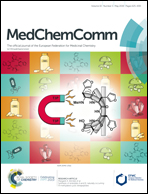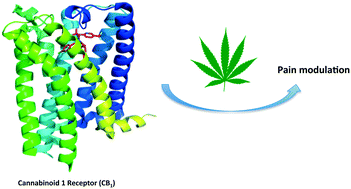 “Cannabis has long been known to limit or prevent nausea and vomiting, lack of appetite, and pain. For this reason, cannabinoids have been successfully used in the treatment of some of the unwanted side effects caused by cancer chemotherapy.
“Cannabis has long been known to limit or prevent nausea and vomiting, lack of appetite, and pain. For this reason, cannabinoids have been successfully used in the treatment of some of the unwanted side effects caused by cancer chemotherapy.
Besides their palliative effects, research from the past two decades has demonstrated their promising potential as antitumor agents in a wide variety of tumors.
Cannabinoids of endogenous, phytogenic, and synthetic nature have been shown to impact the proliferation of cancer through the modulation of different proteins involved in the endocannabinoid system such as the G protein-coupled receptors CB1, CB2, and GRP55, the ionotropic receptor TRPV1, or the fatty acid amide hydrolase (FAAH).
In this article, we aim to structurally classify the antitumor cannabinoid chemotypes described so far according to their targets and types of cancer. In a drug discovery approach, their in silico pharmacokinetic profile has been evaluated in order to identify appropriate drug-like profiles, which should be taken into account for further progress toward the clinic.
This analysis may provide structural insights into the selection of specific cannabinoid scaffolds for the development of antitumor drugs for the treatment of particular types of cancer.” https://www.ncbi.nlm.nih.gov/pubmed/31214034
“Antitumor effects of cannabidiol” http://www.ncbi.nlm.nih.gov/pubmed/14617682
“Anti-tumour actions of cannabinoids.” https://www.ncbi.nlm.nih.gov/pubmed/30019449
“Extensive preclinical research has demonstrated that cannabinoids, the active ingredients of Cannabis sativa, trigger antitumor responses in different models of cancer.” https://www.ncbi.nlm.nih.gov/pubmed/29940172

 “The endocannabinoid system is an endogenous pathway comprised of the cannabinoid receptors 1 and 2 (CB1 and CB2), their endogenous ligands known as endocannabinoids, and the enzymes responsible for their synthesis and degradation. The endocannabinoidome extends this system to include other receptors such as TRPV1, PPARα, GPR55 and 5-HT1A. An extensive amount of research is now linking the endocannabinoidome to intestinal health through fascinating mechanisms that include endocannabinoid receptor expression in the gut and interplay with the intestinal microbiota. A dysregulated endocannabinoid system may lead to inflammatory bowel disease and colon cancer.”
“The endocannabinoid system is an endogenous pathway comprised of the cannabinoid receptors 1 and 2 (CB1 and CB2), their endogenous ligands known as endocannabinoids, and the enzymes responsible for their synthesis and degradation. The endocannabinoidome extends this system to include other receptors such as TRPV1, PPARα, GPR55 and 5-HT1A. An extensive amount of research is now linking the endocannabinoidome to intestinal health through fascinating mechanisms that include endocannabinoid receptor expression in the gut and interplay with the intestinal microbiota. A dysregulated endocannabinoid system may lead to inflammatory bowel disease and colon cancer.”

 “Mammalian ω3- and ω6-PUFAs are synthesized from essential fatty acids (EFAs) or supplied by the diet. PUFAs are constitutive elements of membrane-architecture and precursors of lipid signaling molecules. EFAs and long chain PUFAs are precursors in the synthesis of endocannabinoid-ligands of the Gi/o-protein coupled cannabinoid receptors 1 and 2 in the endocannabinoid-system, which critically regulates energy homeostasis, as metabolic signaling system in hypothalamic neuronal circuits, and behavioral parameters. We utilized the auxotrophic fatty acid desaturase 2 deficient (fads2-/-) mouse, deficient in long chain PUFA-synthesis, to follow the age dependent dynamics of the PUFA pattern in the CNS-phospholipidome in unbiased dietary studies of three cohorts on sustained long chain PUFA-free, ω6-arachidonic and ω3-docosahexaenoic acid supplemented diets and their impact on the precursor pool of CB1 ligands. We discovered the transformation of eicosa-all cis-5,11,14-trienoic acid, uncommon in mammalian lipidomes, into two novel endocannabinoids, 20:35,11,14-ethanolamide and 2-20:35,11,14-glycerol, acting as ligands of CB1 in HEK293-cells. Labeling experiments excluded a Δ8-desaturase activity and proved the position-specificity of FADS2. The fads2 -/- mutant might serve as an unbiased model in vivo in the development of novel CB1-agonists and antagonists.”
“Mammalian ω3- and ω6-PUFAs are synthesized from essential fatty acids (EFAs) or supplied by the diet. PUFAs are constitutive elements of membrane-architecture and precursors of lipid signaling molecules. EFAs and long chain PUFAs are precursors in the synthesis of endocannabinoid-ligands of the Gi/o-protein coupled cannabinoid receptors 1 and 2 in the endocannabinoid-system, which critically regulates energy homeostasis, as metabolic signaling system in hypothalamic neuronal circuits, and behavioral parameters. We utilized the auxotrophic fatty acid desaturase 2 deficient (fads2-/-) mouse, deficient in long chain PUFA-synthesis, to follow the age dependent dynamics of the PUFA pattern in the CNS-phospholipidome in unbiased dietary studies of three cohorts on sustained long chain PUFA-free, ω6-arachidonic and ω3-docosahexaenoic acid supplemented diets and their impact on the precursor pool of CB1 ligands. We discovered the transformation of eicosa-all cis-5,11,14-trienoic acid, uncommon in mammalian lipidomes, into two novel endocannabinoids, 20:35,11,14-ethanolamide and 2-20:35,11,14-glycerol, acting as ligands of CB1 in HEK293-cells. Labeling experiments excluded a Δ8-desaturase activity and proved the position-specificity of FADS2. The fads2 -/- mutant might serve as an unbiased model in vivo in the development of novel CB1-agonists and antagonists.” “Bipolar disorder (BD) is a debilitating, lifelong neuropsychiatric illness characterised by unsteady mood states which vacillate from (hypo)mania to depression. Despite the availability of pharmaceutical agents which can be effective in ameliorating the acute affective symptoms and prevent episodic relapse, BD is inadequately treated in a subset of patients.
“Bipolar disorder (BD) is a debilitating, lifelong neuropsychiatric illness characterised by unsteady mood states which vacillate from (hypo)mania to depression. Despite the availability of pharmaceutical agents which can be effective in ameliorating the acute affective symptoms and prevent episodic relapse, BD is inadequately treated in a subset of patients.

 “Currently, the involvement of the endocannabinoid system in cancer development and possible options for a cancer-regressive effect of
“Currently, the involvement of the endocannabinoid system in cancer development and possible options for a cancer-regressive effect of  “The acute toxicity of organophosphorus-based compounds is primarily a result of acetylcholinesterase inhibition in the central and peripheral nervous systems. The resulting cholinergic crisis manifests as seizure, paralysis, respiratory failure and neurotoxicity. Though overstimulation of muscarinic receptors is the mechanistic basis of central organophosphorus (OP) toxicities, short-term changes in synapse physiology that precede OP-induced seizures have not been investigated in detail. To study acute effects of OP exposure on synaptic function, field excitatory postsynaptic potentials (fEPSPs) were recorded from Schaffer collateral synapses in the mouse hippocampus CA1 stratum radiatum during perfusion with various OP compounds. Administration of the OPs paraoxon, soman or VX rapidly and stably depressed fEPSPs via a presynaptic mechanism, while the non-OP proconvulsant tetramethylenedisulfotetramine had no effect on fEPSP amplitudes. OP-induced presynaptic long-term depression manifested prior to interictal spiking, occurred independent of recurrent firing, and did not require NMDA receptor currents, suggesting that it was not mediated by activity-dependent calcium uptake. Pharmacological dissection revealed that the presynaptic endocannabinoid type 1 receptor (CB1R) as well as postsynaptic M1 and M3 muscarinic acetylcholine receptors were necessary for OP-LTD. Administration of CB1R antagonists significantly reduced survival in mice after a soman challenge, revealing an acute protective role for endogenous CB1R signaling during OP exposure. Collectively these data demonstrate that the endocannabinoid system alters glutamatergic synaptic function during the acute response to OP acetylcholinesterase inhibitors.”
“The acute toxicity of organophosphorus-based compounds is primarily a result of acetylcholinesterase inhibition in the central and peripheral nervous systems. The resulting cholinergic crisis manifests as seizure, paralysis, respiratory failure and neurotoxicity. Though overstimulation of muscarinic receptors is the mechanistic basis of central organophosphorus (OP) toxicities, short-term changes in synapse physiology that precede OP-induced seizures have not been investigated in detail. To study acute effects of OP exposure on synaptic function, field excitatory postsynaptic potentials (fEPSPs) were recorded from Schaffer collateral synapses in the mouse hippocampus CA1 stratum radiatum during perfusion with various OP compounds. Administration of the OPs paraoxon, soman or VX rapidly and stably depressed fEPSPs via a presynaptic mechanism, while the non-OP proconvulsant tetramethylenedisulfotetramine had no effect on fEPSP amplitudes. OP-induced presynaptic long-term depression manifested prior to interictal spiking, occurred independent of recurrent firing, and did not require NMDA receptor currents, suggesting that it was not mediated by activity-dependent calcium uptake. Pharmacological dissection revealed that the presynaptic endocannabinoid type 1 receptor (CB1R) as well as postsynaptic M1 and M3 muscarinic acetylcholine receptors were necessary for OP-LTD. Administration of CB1R antagonists significantly reduced survival in mice after a soman challenge, revealing an acute protective role for endogenous CB1R signaling during OP exposure. Collectively these data demonstrate that the endocannabinoid system alters glutamatergic synaptic function during the acute response to OP acetylcholinesterase inhibitors.”